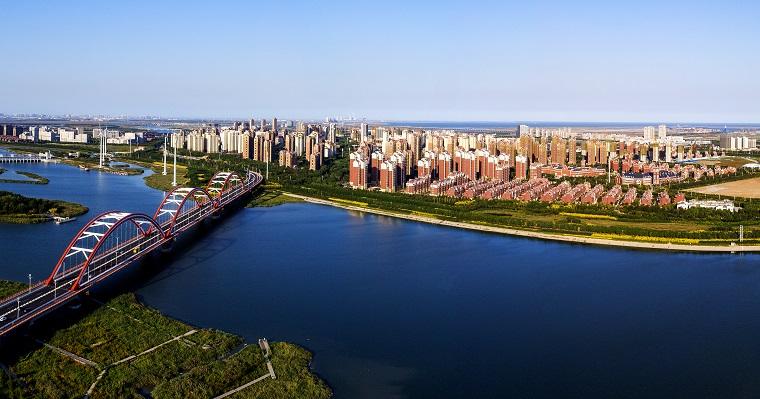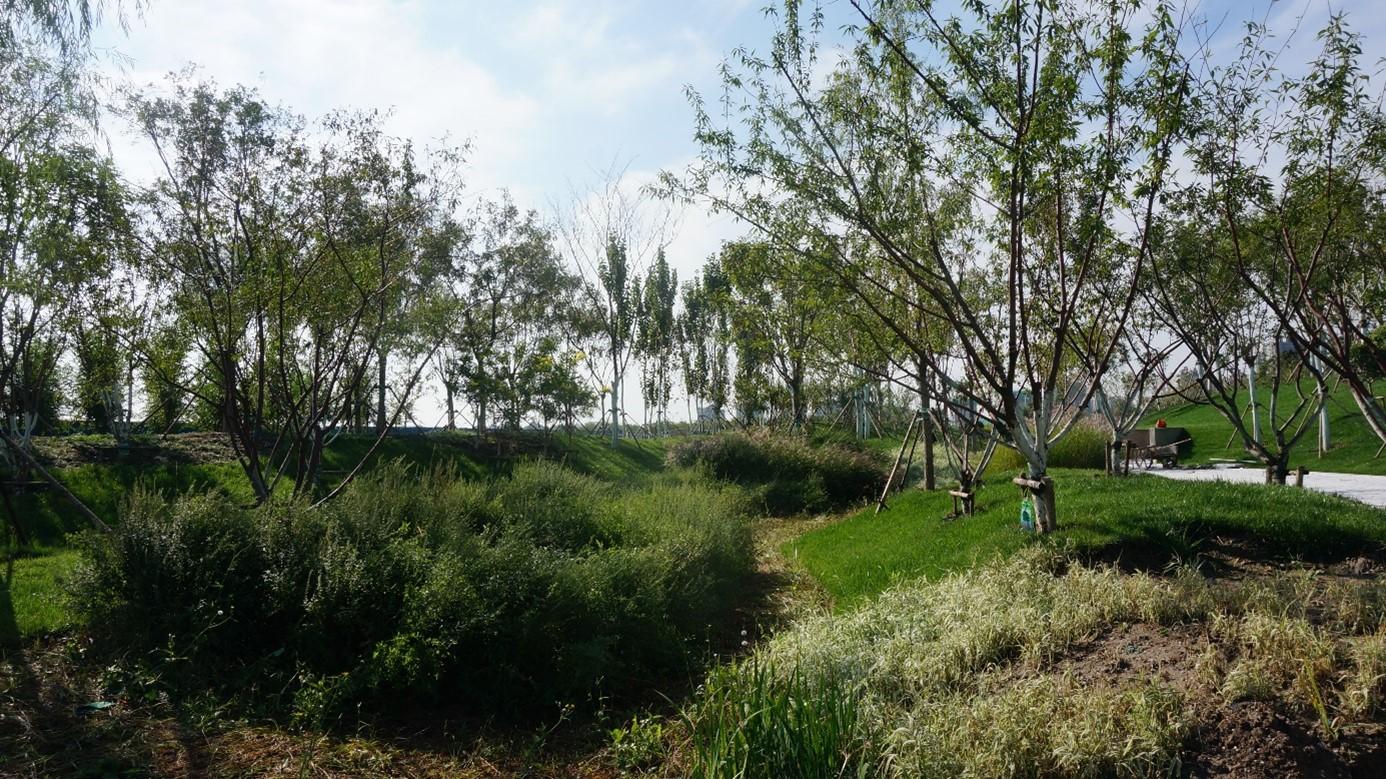Last updated: June 2024
The Sino-Singapore Tianjin Eco-City (SSTEC) is a bilateral project between Singapore and China with a large scale private-sector involvement with the objective to "transform the 34 km2 barren, non-arable land and polluted wastewater ponds into ... a thriving city which is socially harmonious, environmentally-friendly and resource-efficient – a model for sustainable development for 350 000 residents. (1,2). The Eco-Valley is an S-shaped, 11 km green spine that runs through the whole Eco-City connecting its centre with sub-centres, all four residential districts, community spaces, multiple parks, commercial zones, and waterside areas as a scenic park providing a place for connectivity, transit, leisure and recreation for residents (1).
Overview
Nature-based solution
- Blue infrastructure
- In-land wetlands, peatlands, swamps, and moors
- Parks and urban forests
- Green corridors and green belts
Key challenges
- Climate action for adaptation, resilience and mitigation (SDG 13)
- Climate change adaptation
- Environmental quality
- Soil quality improvement
- Green space, habitats and biodiversity (SDG 15)
- Green space creation and/or management
- Regeneration, land-use and urban development
- Conversion of former industrial areas
- Promote natural styles of landscape design for urban development
- Water management (SDG 6)
- Improvements to water quality
- Health and well-being (SDG 3)
- Creation of opportunities for recreation
- Economic development and employment (SDG 8)
- Economic development: service sectors
Focus
Creation of new green areas, Ecological restoration of degraded ecosystems
Project objectives
- Connection of important but separate parts of the city such as the city centre with sub-centres, residential districts, commercial zones and community spaces
- Increase the green area in Tianjin
- Rehabilitation of non-arable and polluted watershed areas
- Provide recreational and leisure green space for the 350,000 residents of the Eco-City (1)
Implementation activities
- Regeneration and revitalization of 34 square kilometres of polluted land and wastewater collection ponds
- Construction of 11 km (3,17 km as of 2018) green infrastructure corridor
- Plantation of native trees, bushes, and vegetation on ca. 180,000 square metres
- Construction of key facilities (1)
Climate-focused activities
Climate change adaptation:
- Other
Main beneficiaries
- Local government/Municipality
- Citizens or community groups
Governance
Management set-up
- Government-led
Type of initiating organisation
- National government
Participatory approaches/ community involvement
- Unknown
Details on the roles of the organisations involved in the project
The Sino-Singapore Tianjin Eco-City (SSTEC) project came to life from the Framework Agreement between Chinese Premier and Singapore Prime Minister in 2007. "The agreement was followed by an Operational Agreement between the Ministry of Housing anf Urban-Rural Development of China (MOHURD) and the Ministry of National Development of Singapore (MND)" (1, p10).
"The organizational structure of SSTEC is built on a complex partnership that involves several private and public sector actors from the collaborating countries, embedded in interconnected institutional relationships. It is mainly governed by the SSTEC Framework Agreement, and other bilateral agreements on management, funding, planning and implementation responsibilities. The coordinator, and the Chinese authority responsible for implementation and all administrative functions is the Sino-Singapore Tianjin Eco-City Administrative Committee (SSTECAC), which was set up specifically for the project." (1, p12)
'The Eco-Valley specifically was planned and designed by the Singaporean National Parks Board, leveraging Singaporean experience on integrated green infrastructure, park connector concepts and water management.' It was constructed and its vegetation and public spaces have been managed by subcontracted companies. (1 p13)
Project implemented in response to ...
... an EU policy or strategy?
No
... a national policy or strategy?
Yes
(The Sino-Singapore Tianjin Eco-City with its Eco-Valley was implemented as a result of bilateral agreement between China and Singapore, thus was was initiated by the government directly.)
... a local policy or strategy?
No
Financing
Total cost
More than €4,000,000
Source(s) of funding
- Public national budget
- Corporate investment
- Multilateral funds/international funding
- National or regional development bank
- Commercial banks
Type of funding
- Earmarked public budget
- Direct funding (grants, subsidies, or self-financed projects by private entities)
- Loan
- Green bonds
- Tax exemption
Non-financial contribution
No
Impacts and Monitoring
Environmental impacts
- Water management and blue areas
- Improved water quality
- Enhanced protection and restoration of freshwater ecosystems
- Green space and habitat
- Promotion of naturalistic styles of landscape design for urban development
- Increased green space area
- Increased conversion of degraded land or soil
- Increased number of species present
- Increased spread of native/heirloom/open-pollinated seed
- Restoration of derelict areas
Economic impacts
- Increased property prices
Socio-cultural impacts
- Health and wellbeing
- Gain in activities for recreation and exercise
Type of reported impacts
Expected impacts, Achieved impacts
Presence of formal monitoring system
Yes
Presence of indicators used in reporting
Yes
Presence of monitoring/ evaluation reports
No evidence in public records
Availability of a web-based monitoring tool
No evidence in public records
References
1) Katona, A. 2018. NATURVATION - Working Paper: Tianjin, China.
2) Katona, A. 2018. NATURVATION - Snapshot: The Eco-Valley of Tianjin Eco-City.
3) Sino-Singapore Tianjin Eco-City. n.a. Key Performance Indicators. Accessed on September 19, 2021. Source link
4) Channel News Asia. 2018. Cool Living in an Eco-City. Channel News Asia. Accessed on September 19, 2021. Source link
5) Ministry of National Development. 2018. Singapore and China to Jointly Promote the Replication of the Tianjin Eco-City’s Experience. Accessed on September 19, 2021. Source link
2) Katona, A. 2018. NATURVATION - Snapshot: The Eco-Valley of Tianjin Eco-City.
3) Sino-Singapore Tianjin Eco-City. n.a. Key Performance Indicators. Accessed on September 19, 2021. Source link
4) Channel News Asia. 2018. Cool Living in an Eco-City. Channel News Asia. Accessed on September 19, 2021. Source link
5) Ministry of National Development. 2018. Singapore and China to Jointly Promote the Replication of the Tianjin Eco-City’s Experience. Accessed on September 19, 2021. Source link


